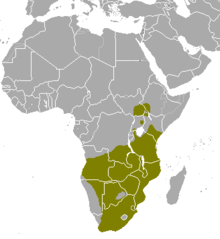Eland
| Eland | ||||||||||||
|---|---|---|---|---|---|---|---|---|---|---|---|---|

Pair of eland, on the right the bull with more massive horns and the typical dewlap |
||||||||||||
| Systematics | ||||||||||||
|
||||||||||||
| Scientific name | ||||||||||||
| Taurotragus oryx | ||||||||||||
| ( Pallas , 1766) |
The eland ( Taurotragus oryx ), also called eland , is an antelope that lives in Africa . Together with the giant eland , which is not larger but has longer horns, it forms the genus of eland .
features
Characteristic features of this species are the tightly twisted, straight horns that are present in both sexes, the "shoulder bump" and the 2 to 15 light horizontal stripes on the upper body. The coat is yellow-brown or pale and turns blue-gray on the neck and shoulders in older animals. In adult males, a dewlap and a tuft of hair develop on the forehead.
With a weight between 500 and 1000 kilograms and a body length of two to three meters, it is the largest antelope species. The shoulder height is 1.5 meters on average. This makes the eland the size of a cattle, but makes a slimmer impression.
distribution
Eland antelopes live in the open plains, dry savannahs and the mountainous grasslands of East, Central and South Africa.
Way of life
Although they are usually leisurely animals, eland can run up to 70 kilometers per hour. They are also known to be very good jumpers. While they rest under the protection of a tree or bush in the heat of the day, they become active at dusk. They are leaf-eaters , but also occasionally feed on grass and dig up tubers and roots with their front hooves .
The herds consist of an average of 25 animals, but under favorable conditions can contain up to 700 individuals. The largest herds seem to be only occasionally unions without any fixed ties. Typically, herds consist of a full-grown bull as well as several cows, young males and young animals. In rare cases, a herd can contain more than one adult male; then the ranking is fought out early on. For this, the horns are pushed against each other, which can lead to serious injuries.
They are perfectly adjusted to the high temperatures of their environment: During the dry season, their body temperature rises by seven degrees. In this way you avoid water loss caused by sweating.
Humans and eland
Eland are likely to be easy to domesticate . Compared to cow's milk, your milk has three times the fat and twice the protein content. In addition, meat and skin could be used. However, attempts at domestication were not made until the end of the 20th century, and so far they have been on a modest scale. Since eland antelopes are frugal and not aggressive towards humans, the experiments could ultimately be successful.
The most common interaction between humans and eland, however, is uncontrolled hunting, which has made the animal rare in large areas of its range. Eland antelopes are most common in the Serengeti , where the population is estimated to be 7,000.
Hazardous situation
The eland is listed by the International Union for Conservation of Nature IUCN as the species Tragelaphus oryx in the Red List of Endangered Species . It is classified as Least Concern .
Web links
Individual evidence
- ↑ Tragelaphus oryx in the red list of endangered species of the IUCN 2012. Posted by: IUCN SSC Antelope Specialist Group, 2008. Accessed February 15, 2013.




